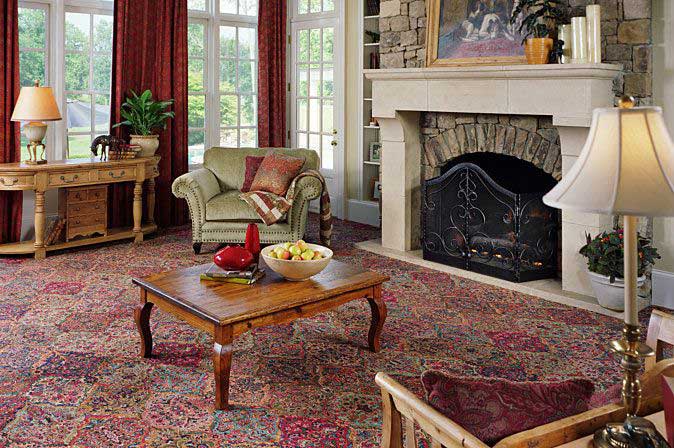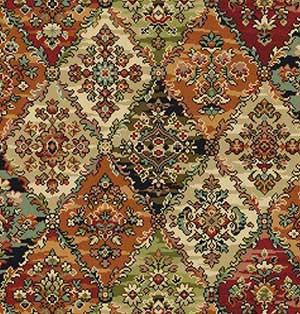All About Carpets

Everything you need to know when buying and maintaining carpets
Carpets, why people use carpets on their floors, what they are, types of carpets and how they are made, how to look after them and how to select and recognise high quality. We also look at fitting, installing carpet, cleaning and maintaining carpet and carpet tiles.
In Britain it is very common that high quality Axminster carpet is used in hard worked heavy traffic areas such as public bars and railway station cafes.
Why carpet? Because it looks great, it is very hard wearing but above all it is very easy to look after. Anyone who has worked in a busy pub knows that, after a heavy night of merriment, the spilt beer, the inevitable discharged contents of someones stomach and the blood and guts is easily dealt with. A once over with a good vacuum cleaner and that carpet will come up like new.
Most houses in Indonesia don't have carpets, not surprising really with the array of interesting floor materials available here, but in recent years there has been a steady increase in the use of carpets both for domestic and commercial use
Carpets are a complex subject with endless variety but if we look at the basics the whole thing will become easier to understand.
Who knows where and when carpets originated but the world's masters are still recognised as the Persians who have been making carpet squares for centuries which travelled the world along the silk road from China in the East to Europe in the West.
Persion Carpets
Persian rugs were, and still are, hand made using goat wool. The wool is hand dyed which gives a rich and natural look and each tuft is hand knotted into a course strong woven backing then clipped to length. Usually using traditional Persian designs and being hand made these carpets are works of art varying enormously in quality and style. To the untrained eye they may look the same but, like paintings, masterpieces can be worth astronomical amounts of money to knowledgeable collectors.
A well made Persian carpet can be very hard wearing and even in heavy traffic areas can last lifetimes.
Machine Woven Carpets
In 1760 the industrial revolution started in Britain with the automation of the cotton industry and, in a country where the pain of bare feet on a cold floor made getting out of bed on a cold winter's morning a horrendous experience, it wasn't long before the Brits turned their hand to automating the weaving of carpets.

Axminster and Wilton Carpets
Two names have become synonymous with machine woven carpets and, rather like the ubiquitous “Cheddar” cheese, these styles of carpet took their names from the villages of their origin Axminster and Wilton. Both are cut pile carpets (the tufts in the carpet are of course known as the pile) in which tufts of sheeps wool are machine woven (not knotted) into a strong hessian backing then cut to length. The essential difference between the two is that Wilton are plain, single colour carpets while Axminster usually have ornate patterns woven into them.
Woven carpets, generally speaking, were always made in two widths - 1 yard wide “runners” for staircases and hallways and 4 yard wide “broadloom” carpets for room floor coverings
Woven carpets are expensive to make and in the 1950s the pursuit of cheaper carpets lead to the development of “needled” carpets. These are made in a totally different way using a row of needles that, in the way a sewing machines works, stitch a row of threads along the length of a rubberised or plasticised woven backing. This technique has two advantages, it is far quicker to produce and it allows a much lower density of pile to be created. (The old Persians would turn in their graves to see such a carpet).
Man Made Fibres in Carpets
Wool is very expensive and it was inevitable that man made fibres would be introduced. These days there is an endless range of different materials and blends available. A major downside with man made fibre carpets (particularly nylon) is their tendency to collect static electricity which can give people shocks and play havoc with electrical equipment.
To form the pile of a carpet individual strands are woven or stitched into the backing so they stand up as loops. The machine then cuts off the ends of these loops leaving cut strands all the same height which form the pile. These are known as 'cut pile' carpets. In recent times many carpets are available that have not had the loops cut off and these are known as 'loop' pile carpets.
Needled Carpets
With the advent of needled carpet manufacture it has become possible to vary the length of the pile and by forming patterns of different length we can give shape to the surface. These are known as 'sculptured pile' carpets. In some cases the highest parts of the sculptured pile is then cut leaving parts of the carpet with cut pile and parts with loop pile.
By now you must be totally asleep with this boring diatribe. You are snoring soundly, the Bali Advertiser is lying over you and you are going to be really fed up when you wake up to find you spilled your coffee on your white tee shirt.
Sculptured Carpets
I have not mentioned Chinese carpets. The Chinese have also produced beautiful traditional carpets for centuries using skills probably passed along the silk road. Chinese carpets tend to have much finer pile being both smaller in diameter and softer than the coarse wool used further West. The Chinese also tend to use picture style motifs as well as traditional patterns and also have a tradition of hand cut sculpturing of the pile.
Fitting or Installing Carpets
Carpets are usually installed with an underlay to give it them a soft feel underfoot. This also reduces wear of the carpet. The best underlay is still latex but these days plastic foams are often used. Expensive carpets use separate underlay while low cost carpets often come with the sponge already formed onto the underside of the backing.
The correct and best way of fitting a carpet uses pinned strips which are nailed around the edge of the room. The carpet is then cut to size and stretched onto the pins. By stretching the carpet in this way the carpet will not move and, more importantly will not bunch up or lift. In Bali you will find most carpet is not pinned but is stuck down to the floor tiles beneath.
Expensive carpets are joined using a special iron and hot melt glue tape giving a very strong joint. In Bali you will find carpets are usually stuck down with glue.
Cleaning and Maintaining Carpets
Good quality carpet is easy to maintain, just vacuum it with a good quality vacuum cleaner. I am talking about a real vacuum cleaner here not one of those sausage things with a flexible hose and a body on wheels you drag along behind you, for carpets these are pretty useless. Hoover invented the best vacuum cleaners. These are 'upright' vacuum cleaners and the secret is that they have a spinning beater roller which teases the pile of the carpet releasing any grit in the root of the pile so the suction can pull it out.
Years ago I was working in a large hospital with several wards carpeted with carpet tiles. It took a wardsman 4 hours to vacuum the carpet using an industrial version of the snake on wheels. As a trial we bought an upright vacuum cleaner with a beater roller. It took the wardsman only 1.5 hours to do the same job using the new machine. I got complaints, there was a problem. The new vacuum cleaner was removing so much dirt from the carpet, dirt that had been there for many years, that he had to stop every quarter of an hour to empty the machine!
The enemy of carpets is grit that sits at the root of the pile where it wears and cuts the threads.
Avoid getting anything oily on man made fibres, you get chemical changes and will never be able to get the stains out.

Carpet Tiles
These days many commercial premises use carpet tiles. These are pieces of carpet 30cms to one metre square made with a heavy rubberised backing. They are generally very hard wearing, can be quickly and easily installed and removed and have the distinct advantage that if individual tiles get worn or damaged they can be easily moved around or replaced. Move offices, simply pick up the tiles and take them with you.
How to Inspect a Carpet
Ok so now you know all about carpets how do we inspect one?
Get on your knees and look at your piles. Push the pile apart, how is it fixed into the backing, is it woven or stitched? How dense is the pile? the denser the better. In a really good carpet it can be difficult to open the very bottom of the pile and see the backing. How long is the pile? A short pile will wear quickly. What materials are used. The best carpets use natural materials, usually wool or even silk for the pile. The cheapest carpets are nylon with a silvery sheen look. Good quality carpets use dyed threads and the colour goes right to the root of the pile, cheap carpets may be printed and the colour is only in the upper end of the pile.
Phil Wilson
Copyright © Phil Wilson September 2009
This article, or any part of it, cannot be copied or reproduced without permission from the copyright owner.
